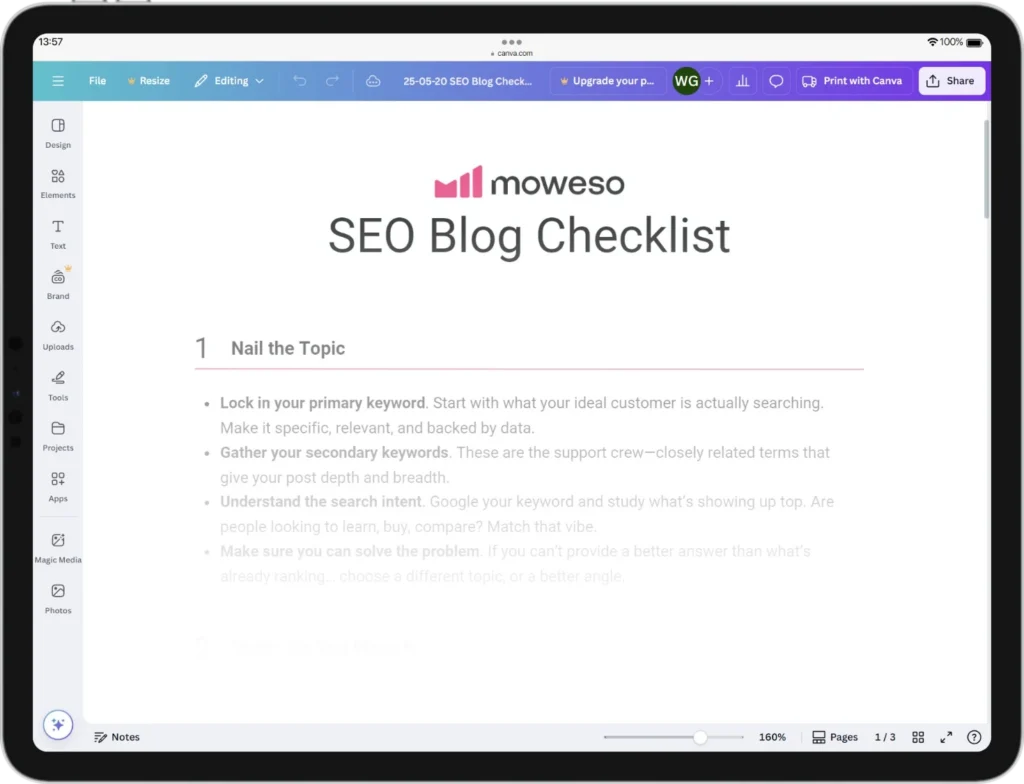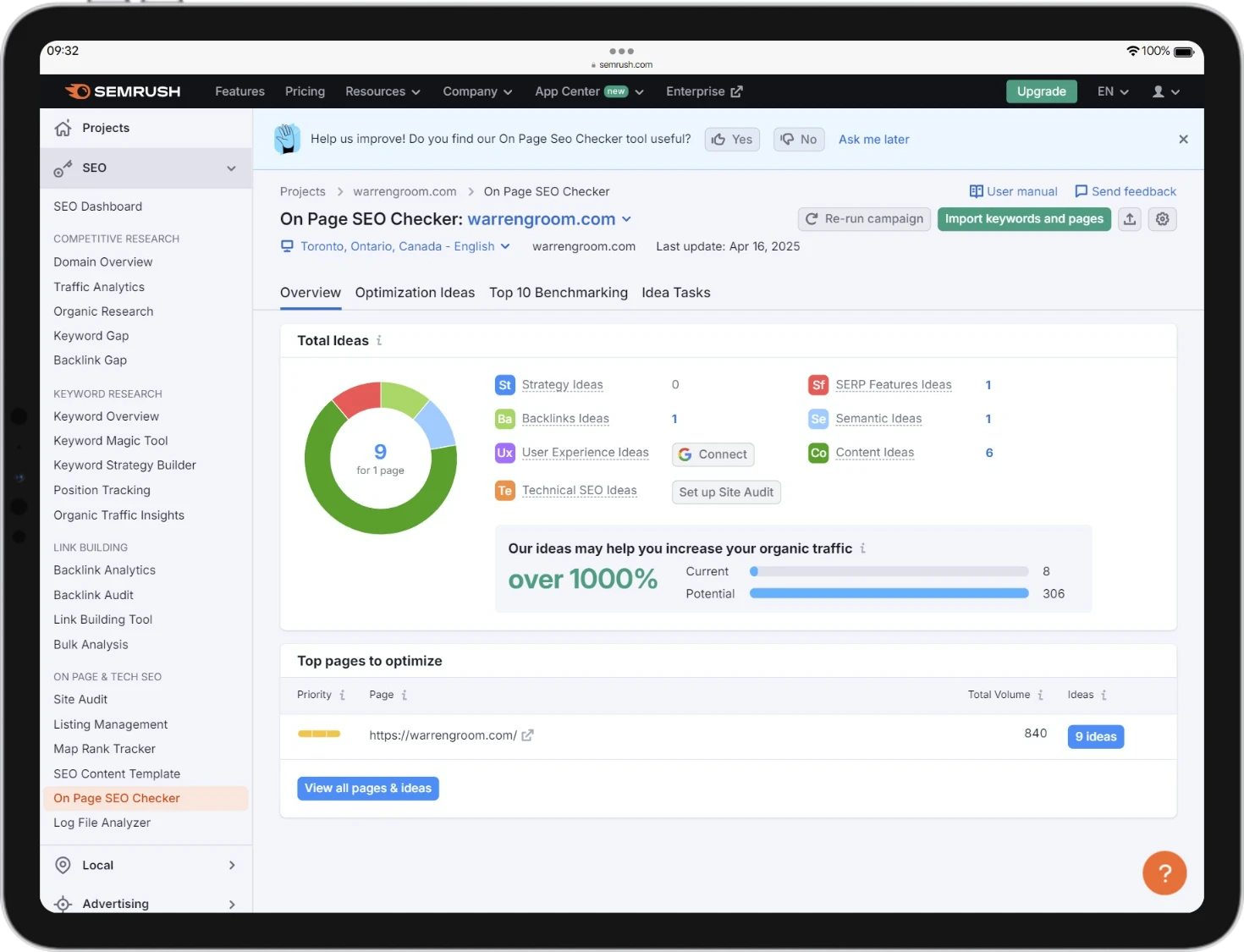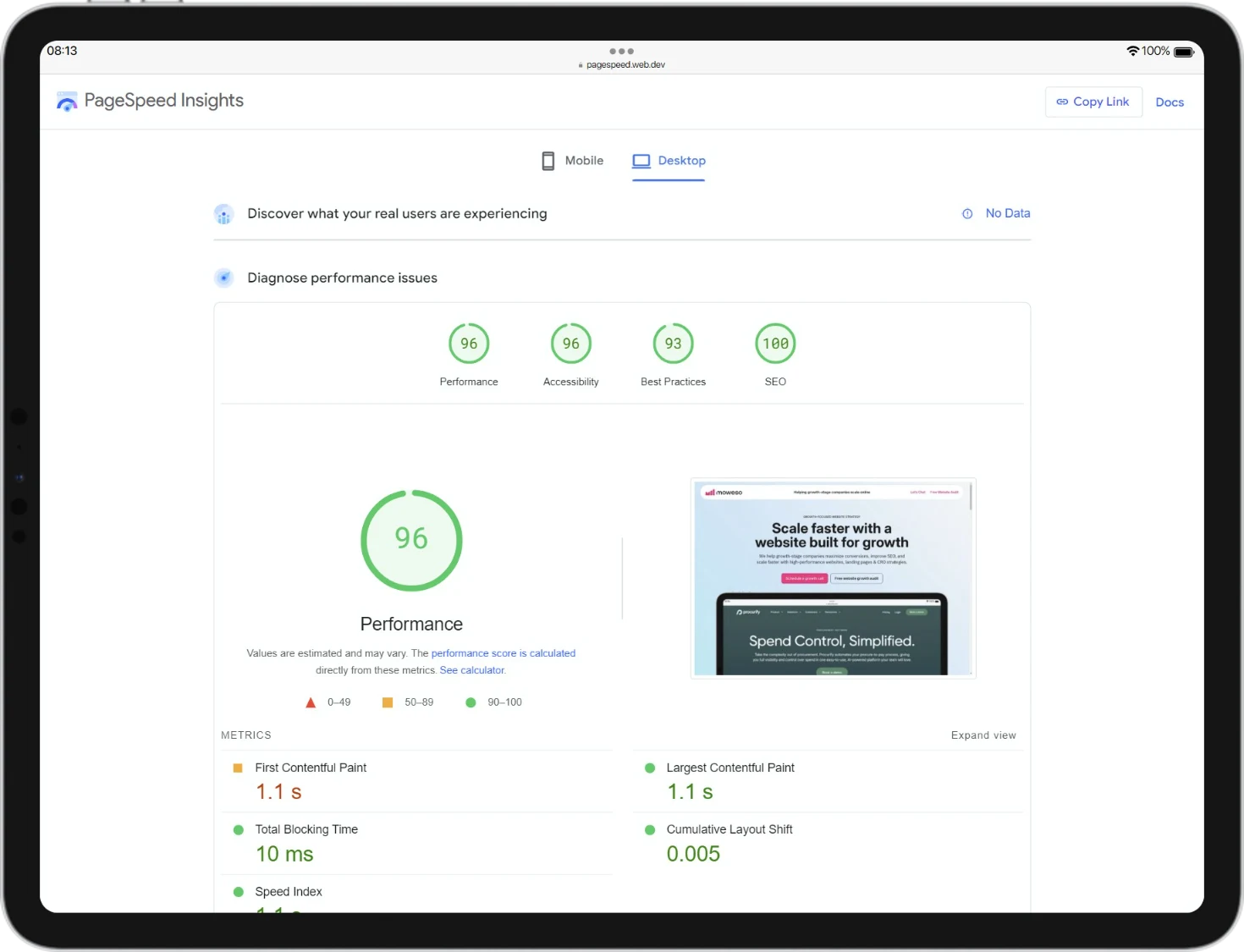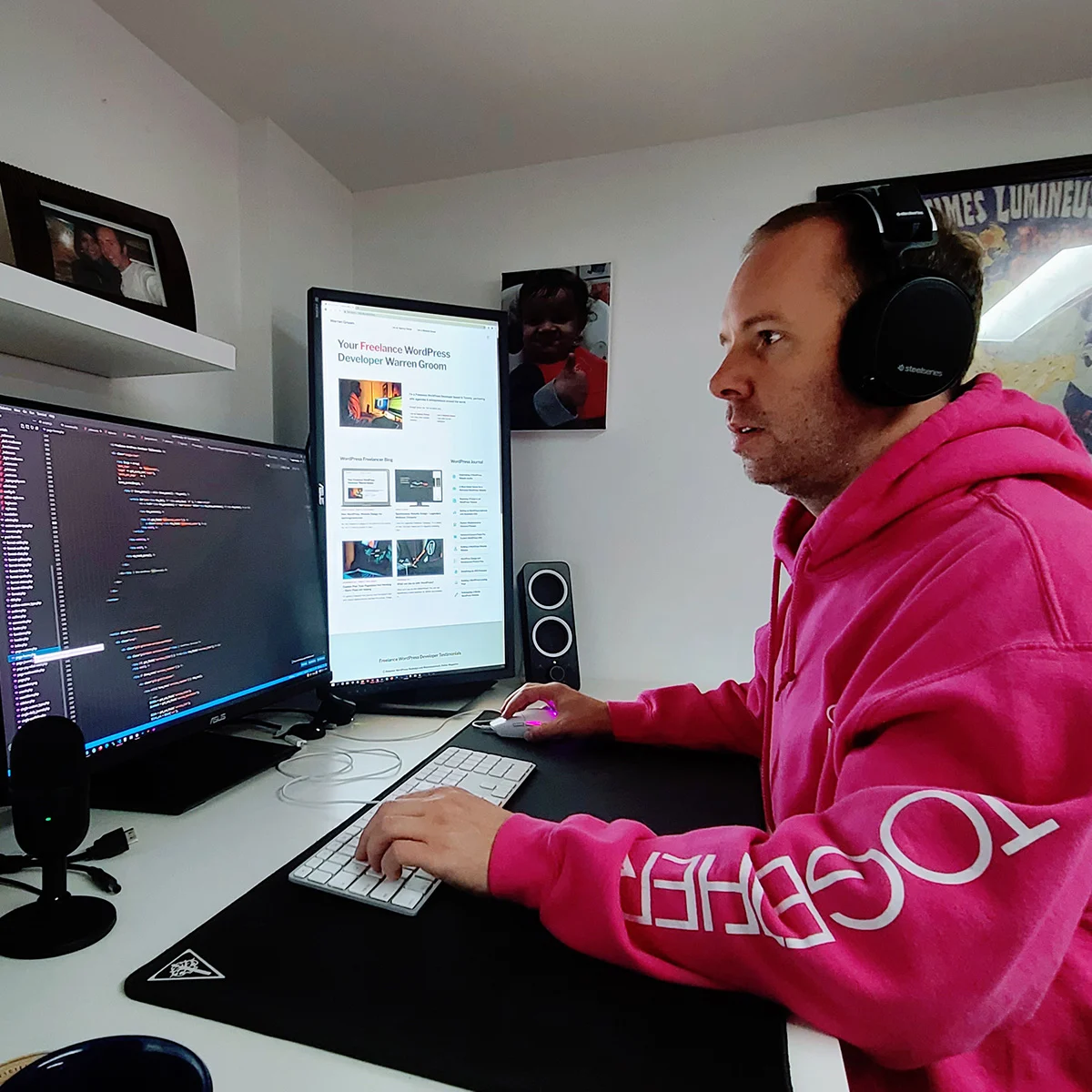Your blog post is live. It’s well-written. It’s optimized. So… why isn’t it ranking?
If you’ve ever stared at Google Analytics wondering why your carefully crafted SEO content is buried on page three—or worse, not indexed at all—you’re not alone. Even well-intentioned content can underperform if it misses the mark on critical ranking factors.
In this post, we’ll explore the most common reasons SEO content doesn’t rank—and more importantly, what to do about it. Whether you’re an in-house marketer, an agency strategist, or a content lead trying to improve your site’s visibility, you’ll find clear, actionable insights to start fixing underperforming pages today.

SEO Blog Checklist Free Download
A practical, no-fluff SEO blog checklist built for startups and growth teams. From keyword research to AI-ready formatting and performance tracking—this guide helps you write content that ranks, resonates, and drives results.
Common Reasons Your SEO Content Isn’t Ranking
Even well-optimized content can fall short if it misses the mark on what Google and users actually want. Below are the most common culprits—and what they look like in the real world.
1. Poor Keyword Targeting
If your content isn’t aligned with the right search terms, it won’t rank—no matter how good it is.
What this looks like: Targeting broad terms like “marketing” instead of specific queries like “email marketing automation for SaaS.”
Why it matters: Google prioritizes content that directly matches the user’s query.
What to fix: Use keyword tools (e.g., Ahrefs, SEMrush, Google Search Console) to find long-tail, intent-rich keywords with realistic competition levels.
Pro tip: Avoid targeting multiple primary keywords on one page. One focus per post = clearer intent.
2. Misaligned Search Intent
You might be writing a deep-dive guide… but the SERP wants a quick answer.
What this looks like: Writing a 3,000-word how-to when the top results are listicles or product pages.
Why it matters: Google’s entire algorithm is designed around giving users exactly what they’re looking for.
What to fix: Google your keyword and analyze the top-ranking formats—match the structure, then improve on it.
3. Thin or Duplicate Content
Low-effort content—or recycled text from elsewhere—doesn’t cut it.
What this looks like: 300-word pages with no original value, or reworded copy from competitors.
Why it matters: Google wants unique, comprehensive content that adds something new.
What to fix: Conduct a content audit. Merge, expand, or delete low-value pages. Aim to add insight, not just repackage it.

4. Technical SEO Issues
If Googlebot can’t crawl or index your page, you’re invisible.
What this looks like: Noindex tags, broken internal links, slow load speeds.
Why it matters: Search engines need access to your content to evaluate and rank it.
What to fix: Use tools like Google Search Console or Screaming Frog to identify crawl errors and fix them. Prioritize fast loading, mobile responsiveness, and proper HTML structure.
If technical SEO fixes aren’t enough, the issue might be deeper. Your Website Isn’t Broken—It’s Just Not Built for Growth explains how foundational limitations can quietly stall rankings.
5. Lack of Quality Backlinks
Content without backlinks is like a party with no invitations—no one knows it’s happening.
What this looks like: Content with zero referring domains.
Why it matters: Backlinks are still one of the top ranking signals. They signal trust and authority.
What to fix: Promote your content. Use outreach, digital PR, or linkable assets (like stats or original data) to earn backlinks naturally.
6. Poor On-Page Optimization
Even great content can be invisible if it’s not structured properly for search engines.
What this looks like: Missing meta titles, unoptimized headers, no internal links, or stuffing keywords unnaturally.
Why it matters: On-page elements help Google understand the topic and hierarchy of your content.
What to fix: Ensure every page has a compelling, keyword-aligned meta title and description. Use H2s/H3s to organize content, and sprinkle internal links naturally to guide both users and crawlers.
A well-optimized page also considers structure, messaging, and CTA design. For a broader view on what makes content convert, see 7 Elements That Make a B2B Website Convert.
Tool tip: Use Surfer SEO or Clearscope to align your on-page content with top-performing competitors.
7. Content Not Indexed
If it’s not in Google’s index, it’s not going to rank. Period.
What this looks like: Content exists on your site but can’t be found in Google search.
Why it matters: Indexing is a prerequisite for visibility.
What to fix: Use
site:yourdomain.com/page-urlto check if your content is indexed. If it’s not, check robots.txt, noindex tags, or request indexing via Google Search Console.
8. Overly Competitive Keywords
Going after high-volume head terms can bury your content before it gets a chance.
What this looks like: Targeting a keyword dominated by high-authority sites (e.g., HubSpot, Moz, Wikipedia).
Why it matters: Google tends to reward established domains for competitive keywords.
What to fix: Target more achievable, long-tail versions of the keyword. For example, instead of “SEO,” go for “SEO for ecommerce sites with lots of SKUs.”
Not all SEO tasks are worth your time—especially if you’re scaling fast. Here’s our guide on SEO for Scaling Startups to help you focus on what works and avoid dead ends.
Pro tip: Use Keyword Difficulty (KD) scores from Ahrefs or SEMrush to assess realistic targets.
9. Ignoring User Experience (UX)
Ranking is only half the battle—if users bounce quickly, Google takes note.
UX is directly tied to content performance. If your page layout or design causes visitors to leave, rankings will suffer. Here’s why your landing page might not be converting — and how to fix it.
What this looks like: Cluttered layout, intrusive popups, unreadable fonts, or walls of text.
Why it matters: Poor UX increases bounce rates and reduces dwell time, both of which hurt rankings.
What to fix: Prioritize readability—short paragraphs, clear fonts, whitespace, mobile-first design. Make sure your site loads fast and navigates intuitively.
10. Neglecting Content Updates
SEO isn’t one-and-done. Content gets stale—and rankings drop.
What this looks like: Blog posts from 2018 still referencing outdated stats or trends.
Why it matters: Google values freshness, especially for time-sensitive topics.
What to fix: Conduct regular content audits (quarterly or bi-annually). Refresh stats, update screenshots, rework outdated advice, and re-promote as needed.
Tool tip: Use Google Analytics or Search Console to identify pages with declining traffic or impressions—great candidates for updating.
How to Fix SEO Content Issues
Now that you know why your SEO content might not be ranking, here’s how to turn things around. These aren’t generic tips—they’re practical fixes grounded in data, tools, and real-world application.
1. Conduct a Comprehensive SEO Audit
Start with a clear diagnosis before applying fixes.
Why it matters: Without a baseline, you’re just guessing. An audit reveals where content is falling short—technically, structurally, or competitively.
How to do it:
- Use Google Search Console to check indexing status, impressions, and page errors.
- Run a crawl with Screaming Frog to uncover broken links, missing tags, or canonical issues.
- Check on-page SEO and keyword usage with Clearscope, Surfer SEO, or Frase.
Output: A prioritized list of content issues to tackle—technical, keyword, and content-level.
2. Enhance Content Quality
Make sure your content is actually better than what’s already ranking.
Why it matters: Google’s Helpful Content updates reward depth, clarity, and originality.
How to do it:
- Add unique insights, case studies, or product knowledge.
- Replace generic intros with stronger hooks.
- Use formatting—bullet points, bolding, inline tables—to improve readability.
- Expand thin pages with actual value, not just word count.
Tip: Don’t just rewrite what’s on the SERP—add something your competitors didn’t say.

3. Optimize Technical SEO
Fix the foundational issues that prevent content from being discovered or ranked.
Why it matters: Google can’t rank what it can’t crawl, render, or understand.
How to do it:
- Improve page load speed with compressed images and lightweight code.
- Check mobile usability using Google’s Mobile-Friendly Test.
- Ensure clean HTML structure (proper H1–H4 order, schema markup if needed).
- Fix noindex tags, 404s, and redirect loops.
Use tools like: Google PageSpeed Insights, GTmetrix, Screaming Frog.
4. Build High-Quality Backlinks
Content needs signals of authority. Backlinks are one of the strongest.
Why it matters: Without inbound links, even great content may not rank competitively.
How to do it:
- Create linkable assets (e.g., original data, expert roundups, infographics).
- Reach out to blogs, partners, and relevant directories.
- Consider digital PR or HARO (Help a Reporter Out) for authority mentions.
- Internally link new content from top-performing pages.
Focus on quality over quantity: A few strong links > dozens of irrelevant ones.
5. Align Content with Search Intent
Make sure you’re answering the question users are actually asking.
Why it matters: Google’s RankBrain and BERT updates prioritize relevance over keyword density.
How to do it:
- Google your target keyword and analyze: are the top results listicles, tutorials, product pages, or thought leadership?
- Adjust your content structure to match—but outshine—the format.
- Include subheaders and content that mirror “People Also Ask” questions.
Reframe your keyword: Not “How to write SEO content” but “Why isn’t my SEO content ranking?
6. Regularly Update and Republish
SEO isn’t a set-it-and-forget-it game.
Why it matters: Content decay is real—rankings drop as competitors publish fresher or better resources.
How to do it:
- Revisit underperforming content every 6–12 months.
- Update stats, internal links, screenshots, and headings.
- Re-promote through email, social, and repurposing.
Even when your content ranks, it still needs to perform. If traffic is coming in but leads aren’t, that’s a separate issue — explore Why Your Website Gets Traffic but No Leads to fix that conversion gap.
Bonus tip: Add a “Last updated” timestamp to show freshness to both users and search engines.
Conclusion: Fix It, Don’t Just Publish and Pray
Publishing SEO content without results isn’t just frustrating—it’s expensive. If your blog posts, guides, or landing pages aren’t ranking, it’s rarely because the algorithm is broken. More often, it’s because your content needs to be refocused, restructured, or revived.
Here’s the good news: each ranking issue is fixable.
By understanding why your content isn’t ranking—and applying specific, intentional solutions—you can start reclaiming lost traffic and unlock better performance from the content you’ve already invested in.
Don’t just hit publish and hope. Optimize with purpose. Revisit what you’ve written. And give your SEO content the best shot at page one.

SEO Blog Checklist Free Download
A practical, no-fluff SEO blog checklist built for startups and growth teams. From keyword research to AI-ready formatting and performance tracking—this guide helps you write content that ranks, resonates, and drives results.

